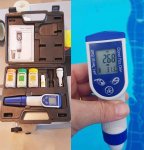Let's suppose that you have two separate bottles of water. Each is one liter.
To one, you add 3.5 grams of sodium chloride. This is usually referred to as Salinity. It is a specific type of TDS.
To the other bottle, you add 3.5 grams of a mixture containing 40% sodium sulfate, 40% sodium bicarbonate, and 20% sodium chloride. This is usually referred to as "TDS" (442 Natural water).
There are many different types of solids that will dissolve in water.
Both have 3.5 grams per liter (3,500 ppm) TDS.
If you use a conductivity meter on each solution, you will get a different conductivity.
That conductivity can be converted into TDS, but only if you use the right conversion chart.
So, when you use a meter, you have to have it set to the correct TDS makeup setting.
When testing the solution with sodium chloride, the meter needs to be set to Salinity. If set to TDS, the assumed makeup is incorrect and will result in an incorrect reading.
When testing the other sample, the setting needs to be set to TDS.
The misunderstanding comes from the use of term TDS. It should say 442 Natural water.
For pool water, the proper setting is Salinity.
The TDS setting is not an appropriate setting because it assumes an incorrect makeup, uses the wrong conversion and results in the wrong result.
When testing any sample, you can only use one setting, which uses a specific conversion chart. The chart is specific to each type of dissolved solid.
Here is a dual use meter and a chart that shows graphs of salinity vs conductivity and TDS (442) vs conductivity.
As you can see, the graphs show different values for conductivity vs TDS for both dissolved solids.
PoolMeter™
Standard Solutions and Buffers
In my opinion, the MyronL PoolMeter should not be dual use because the only appropriate setting is Salinity. The TDS setting is not appropriate for pool water and only causes confusion. Pool stores pour in the water and set the meter to Salinity and take a measurement then set it to TDS and take another measurement thinking that the salinity setting measures only salt and the TDS setting measures everything, which isn't accurate.
A conductivity meter measures the conductivity of the water. The conductivity is affected by all charged ions, such as sodium, chloride, calcium, sulfate, bicarbonate etc.
So, a meter set to Salinity does not just measure salt (sodium chloride).
Because the mixture is not 100% sodium chloride, the conversion won't be exact, but it's close enough because most of the TDS is salt (sodium chloride).
So, it's not accurate to say that the meter measures only salt when set to salinity and measures all TDS when set to TDS.
TDS is not a setting that should be used unless the TDS makeup is a 442 mixture.
If the TDS is something other than salt (sodium chloride) or 442, the correct setting is conductivity in microsiemens and then you use the appropriate chart to convert the conductivity into "TDS".
If you don't know what the composition of the TDS is, conductivity can only give you a rough idea of the TDS.
You would need to conduct further tests to identify the components of the TDS.
You could evaporate the water and weigh the leftover solids. That will tell you the TDS, but not the composition of the solids.
You could do ion specific tests to determine if specific ions are present.
When dealing with an unknown sample, you typically would need to do much more sophisticated tests if you really had to know the composition of the various ingredients of the TDS.
The K-1766 test kit is specific to chloride. As long as most of the TDS is salt (sodium chloride), the K-1766 should match a conductivity meter set to Salinity.
Many SWGs use conductivity to measure salinity.
Hayward aquarite is unique in that it uses the performance of the cell to calculate salinity. The cell performance is based on chloride levels and water temperature (assuming the cell is working correctly).
As long as most of the TDS in a pool is sodium chloride, a conductivity meter set to salinity, a K-1766 and a Hayward aquarite should match.
A mismatch could indicate that the TDS is not mostly sodium chloride.
For example, if you had pool water that matched the 442 profile, you would get a big difference between the conductivity meter, the K-1766 and the Hayward aquarite.



